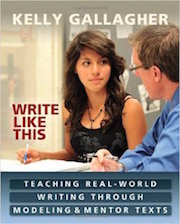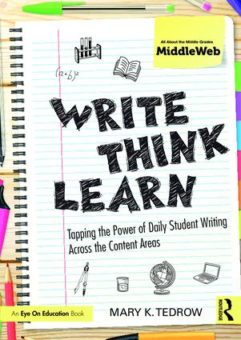Make Writing a Daily Ritual in Every Subject
I was first introduced in the 1980’s to the revolutionary idea that students should write daily in the English classroom. (Yes, writing every day was radical thinking in the Ferris Bueller era!)
I remember trying but eventually abandoning the practice since the writing did not relate to other activities going on in class and seemed to go nowhere.
I returned to daily writing later, following a fellowship in the National Writing Project. After years of refining the daily writing habit, I cannot imagine teaching a class in any subject without the prompting that inspires us all to think and talk about the themes and concepts we will focus on for the day.

Short, ungraded but frequently shared writings are the easiest way to achieve the “low stakes, high frequency” directive suggested by Peter Elbow for improving the writing of all of our students. The quality of the writing doesn’t matter nearly as much as the frequency.
Students need to produce a lot of bad writing – some of which could be revised with guidance – before they can produce good writing. But in practice, the daily writing around easily accessible concepts can also be exhilarating.
Input and output
Where much of teaching seems focused on input – students being told what to think – writing is output, where every student is invited to converse around the subject. For most, the invitation to participate in these guided discussions with peers is great fun. And if we like something, we are more likely to practice it, and eventually improve.
Quickly composed daily writings help students do a number of things: discover their own thinking, hear their ‘written voice,’ practice and fail without risk, practice and succeed without risk, as well as practice, practice, practice to gain the fluency needed to easily translate thoughts to the page, all the while increasing the likelihood of producing better writing.
Daily writing is not just for English class
This daily writing should not be confined to the English classroom. Students should be writing frequently in all content, primarily so they can write their way to an understanding of curricula.
Writing is a way of knowing. It is how you discover what you know and is an important tool for reflecting on and then owning learning. In the study of content, these writings should be constructed responses (students putting their own ideas on the page) rather than notetaking, which is often an exercise in copying teacher-formulated thinking or summaries from a reading.
Unlike my unconnected classroom journaling of old, I’ve found the best prompting is tied to curriculum and produces meaningful (to the student) writing. The best prompts ask students to reflect on their own experiences and connect them to the course content. Everyone knows their own experiences and so it is easy to write from this perspective.
Launching a daily writing ritual with your students
Three simple steps will set the stage:
- Ask students to purchase a notebook (or designate a section of a notebook) and devote it entirely to writing. I prefer a separate bound journal but leave the cost factor up to the student. They can spend as much or as little as they like so long as it is larger than 5 by 7 and is portable so they can carry it every day. I buy up piles of composition books when I see them on sale and keep them in the room to hand to any student who does not have one when we initiate our daily writing practice.
- Number every page on the top or bottom outside corner like a book. This is an easy but effective tool to manage the writing as well as student behavior. Somehow the numbered pages make students reluctant to tear out pages for use in another class or context. Also, page numbers allow students to index their ideas so they can locate the tender, early thoughts that might feed into higher stakes writing assignments or help them locate information for review.
- Aim to provide a daily prompt so students have the chance to write every day. After writing, encourage students to share their writing with their peers.
Daily writing needs to be shared
Sharing writing is an important part of our daily writing process. A few guidelines can help students feel comfortable with the idea of sharing writing out loud.
First, if you plan to have them share, warn students before they write. “This writing will be shared,” I state prior to the prompting. Some editing of content will naturally occur if the topic is personal. Students can self-select the experiences that they are willing to risk sharing.
You can also choose to have students share with a partner. For partner sharing I let them choose their own partners. If students are unpartnered, then I share with that student. I always write to my prompt in at least one class during the day so I also have something to share. In other classes, when students write, I still model by writing with them. (My subsequent journal entries can be on topics of my own choosing. I get a lot of writing completed that way!)
Before sharing begins, I remind them: “Simply read what you wrote, rather than talking about the writing. Reading what you wrote will be much faster, and you will start to hear your ‘written voice.’” Hearing a written voice helps students understand the concept of style and voice as we go through our course of study. Besides hearing their own voice, they will quickly become adept at recognizing the voice of their peers and deepen their understanding of “writing style” from that experience.
After partner sharing, I often ask for a large group share. “Would anyone like to share? Or maybe you’d like to volunteer someone to read who had ideas you think we all should hear?” Then we share some of what we have written with everyone.
Not all student writing is shared
If students are collecting for a future assignment, this writing might not be shared. A favorite prompt of mine is the low-risk “If you had to write this paper right now, what would you write? You have ten minutes. Go.”
Ten minutes can take a student a long way to outlining their ideas. This kind of writing does not need to be shared since it’s intended for collecting rather than for discussion. The low risk nature of the journal entry means they are less likely to block their thinking with the worry of “correctness.” It provides a better chance to record real thinking first.
That said, modeling using student generated text should be a focus for all classes so students can see how their peers approach a task. Students will learn from successful examples and can react to the ideas presented by the other members of the course, creating a true learning community. Hearing peers helps students aspire to next steps in writing and thinking. It is the ideal “zone of proximal development” championed by Vygotsky and other theorists.
Assessing daily writing
If daily writing is assessed in any way, it should be around the ideas in the writing rather than the quality.
For instance, you might ask students to flag a page where they wrote about something that confused them or where they wrote a strong explanation. Then you can look only at that page.
Or, as Peter Elbow recommends, if students won’t write without a grade then give a grade, but make it a compliance grade based on whether or not they participated. I have found that when students are sharing and the writing is put to immediate use to spark discussion or set a purpose, then students see the writing as valuable and interesting and discussions about grades fall away.
A great bank of prompts to get you started
If you think you are ready to take on the task of daily writing but aren’t sure where to begin, you are in luck.
The New York Times Learning Network publishes writing prompts for student writers, organized thematically and tied to short non-fiction reading. It’s an amazing resource. Start with the NYT’s original 650 prompts and follow the updates and additions you’ll find as you jump through their years of new prompts (the most recent update, as of this writing, is November 2024).
If nothing else, these prompts, most of which follow the criteria of tying personal experience to content, will give you a model of how to formulate good prompting that provides most students entry into a topic.
Once you get the hang of it, your prompting will help students think about content, share their ideas around curriculum with each other, and cement your teaching through the writing process — all while improving their composing skills!
Images courtesy of Project Write Inc.
Read Mary Tedrow’s post on
using Daybooks for daily writing

Mary currently teaches at Shenandoah University and is the co-founder of Project Write, a non-profit corporation dedicated to developing young writers. In 2024, she was elected to the Winchester City school board.
Tedrow’s book Write, Think, Learn: Tapping the Power of Daily Student Writing Across the Content Areas (2017), is published by Routledge/Eye on Education in partnership with MiddleWeb. Visit her website.







































Yes, I agree that writing helps me plan ideas, and practise without risk. Furthermore, I believe that writing helps improve your creativity and coming up with new and interesting ideas. However, i believe that writing can take a long time, so I recommend that students do this once a week rather than once a day!
Hi, Mary. THANK YOU for this post. I’m in complete agreement that writing should be done in every class daily because it builds critical thinking skills, writing stamina, and provides teachers with formative data. My favorite reason to use mini-daily writing tasks is to offer students a pause in their learning to reflect, synthesize, and build their own schema for the new concept using writing.
MY FAVORITE approach to incorporating writing every day is through Linda Rief’s Quick Write method. QWs are daily, mini-writing tasks that are not graded. The teacher simply ask a question, and students spend 2-3 minutes composing their answers.
I wrote about it here http://www.empoweringells.com/2016/10/08/quick-writes/.
Because I teach English learners, QWs also develops their writing skills in addition to the benefits mentioned above. If all content area teachers use QWs, their ELs would retain more information more readily and make connections more frequently.
QW is one of my instructional tools I use EACH DAY!
Thank you for your post.